About Guitar Camp
Guitar Mania Quiz
Class Descriptions
Location and Accommodations
Food
Camp Fees
Instructors
Register
Contact
Sample Schedule
Camper Comments
Links
News
Index to This Story
Left Hand Exercises
Right Hand Exercises
Harp Effect Exercises
Generosity
See the Player's Soul
Pierre's Lunches
Brazilian DADGAD
About Music
Top
Top
Top
Top
Top
Top
Top
Top
Top
Top
Imagine a gracious, friendly, completely un-snobby music genius who conjures breathtaking, heart-stopping beauty from his guitar, and who is also a fine teacher. Quite a mental feat, but if you can do it, you might be imagining Pierre.
Here’s what Pierre showed and told us:
Saturday morning, Pierre began by asking each player to introduce him- or herself and to tell us what we hoped to learn. Our group of thirteen students made responses ranging from, “I want to learn technique” to “I want to learn how to make my arrangements more interesting” to “I want to absorb some of your musicality and to open my mind to what you hear.”
Pierre listened carefully to players’ comments, then told us about his own relationship with the guitar. He said that he began studying piano when he was seven. He studied with his first teacher for a few years. She inspired him and taught him useful musical skills. Somehow, that first teacher became unavailable, and his second teacher gave him the blues. Pierre owned a guitar for a few years as a young teenager, but did not play it. One day, a friend of Pierre’s asked if he might clean off the guitar, repair a few problems and play it. Pierre agreed, the friend played, and upon hearing his friend, Pierre resonated with the instrument for the first time and wanted to play.
He told us that he is self-taught. As you might know, Pierre’s competence on the guitar is a world historical phenomenon. He is consummately flexible with both hands. The fingers of his left hand move with marvelous independence, strength, dexterity and intelligence. Somehow, he learned by himself how to achieve this superb facility!
After introductions, Pierre spent two hours teaching us exercises. They were REALLY GOOD exercises. Our left hand exercises centered around stretching. After explaining some anatomical facts about the musculature of our hands, Pierre led us through an exercise intended to develop a seven-fret stretch over four consecutive strings. The exercise was challenging, but manageable, and I found it immensely helpful.
I don’t know why I was surprised to find that Pierre was an excellent teacher – perhaps because I’ve studied with some other well-known players who had no idea how to guide students to more advanced levels, and had not bothered to prepare a curriculum for our workshops. By contrast, Pierre watched and listened to his students, and he had a deep pocket full of exercises. If someone could not accomplish the exercise, he always knew how to break it down into simple increments. The fact that our group included players of many levels never hampered our progress because Pierre knew how to adapt the exercises to every level. He paid attention to the precision with which each student performed the stretches.
I enjoyed those exercises, and I enjoyed his guidance. My left hand has never felt so intensively stretched and strengthened, and I have no doubt that those stretches will take me a long way if I do them regularly.
We spent our final Saturday morning hour working on right hand exercises. Pierre showed us different arpeggio patterns, including a cross string pattern in which the ring plucks one, the middle plucks two, the index plucks three, then the middle plucks four. The thumb rests on six. We picked away in 4/4 time for several minutes.
When this became easy, Pierre asked us to pluck the bass string on the first beat of each measure, for four cycles, then to pluck the bass on the second beat of each measure for four cycles, then to pluck the bass on the third beat of each measure for four cycles, then to pluck the bass on the fourth beat of each measure for four cycles. I could see in this exercise the rudiments of Pierre’s endlessly varied phrasing and bass lines. For me, it was a mental challenge as well as a physical one.
Before we broke for lunch, Pierre showed us how to alter this pattern farther by playing doublets and triplets with our thumbs, both ON and BETWEEN various beats of the four. He also led us through a variation in which we muted the bass string that we had just plucked, using the thumb that had just struck the string.
In case you’re interested, Pierre went out for Mexican food on the first day and Italian on the second. He seemed excited about these meals, and way less interested in the organic carrots I kept offering him. I stayed at the beautiful workshop venue and ate my organic carrots and strawberries as I spoke with friends and watched the beautiful swans.
I got a bit dizzy with cognitive dissonance as I sat in the sunny, windless coastal California beauty, reveling in my studies with this fine player, eating delicious food, thinking of our country’s imperialist conquest in Iraq, thinking that people were dying at the very moment when I was enjoying the peace and beauty.
We resumed after lunch in a magical setting. It was a redwood deck supported by four very tall old redwood trees. Pierre asked everyone to play a tune. He asked class members to share their responses, then he offered his comments.
During this session, he told us so many fascinating things about music and guitar that I can’t remember all he said. I was just trying to absorb as much as I could. I remember Pierre saying that it is important to vary passages that repeat within a tune. He said this many times, and demonstrated in myriad ways. He said that, with every repetition, you should try to vary SOMETHING about the passage – a different bass note, a different bass line, different rhythm, different phrasing for the melody notes, different position on the fretboard (even for exactly the same notes), different vibrato technique, no vibrato. He told us that he experienced as generous those guitar players who gave lots of variations because they are giving so much. Generous…
Pierre said that we should not let the guitar play us but rather we should play our guitars. He explained that it is easy to fall into the beautiful sounds produced by the obvious shapes and textures in any given tuning. He told us that it is important to define a melody, and to state the melody clearly. According to Pierre, it is fine to forsake the melody for a little while in favor of a pleasing texture or in order to emphasize a rhythmic or vocal element, but ultimately only a clearly stated melody can make a tune coherent and moving. He told us that a guitar player can draw an audience close and create intimacy by playing one note at a time.
Meanwhile, I was fascinated by another of Pierre’s abilities that revealed itself during this critiquing session. It seemed to me that he could see right to the soul of every guitar player. He could read the qualities of the playing, and know the soul of the player. I don’t know how to describe this. Maybe the comments above about generosity give a hint of what I mean. He is a very perceptive human being as well as musician. I was thinking that his sensitivity to people and to life are among the qualities that make his music so beautifully moving.
I loved a comment Pierre made that afternoon. He said: A real musician will appreciate the music of even the most beginning-level player who is really involved in his or her music. I thought, “Yes, because a real musician hears and responds to MUSIC, any music made with intention and awareness.” I was glad he made that comment because I was too shy to play on that first afternoon, even though Pierre pointed directly at me and told me he wanted to hear me play. I managed to put him off until the next afternoon, and was able to play despite my stage fright because I really believed that he would appreciate my music, as long as I could make it musical, even if I couldn’t make it virtuosic [sic?].
Sunday morning, we revisited the left hand stretch. We played a C major scale in DADGAD – playing the notes in different places on the fretboard in order to achieve different tonal qualities with the scale. Pierre wanted us to achieve harp-like effect by playing the scale degrees on as many different strings as possible so that we could hear all of the tones ringing at once. He told us to search until we found the notes in the positions we wanted. This effort produced some counterintuitive results: in some cases it required that a higher scale degree be produced on a “lower” string. Pierre emphasized the fact that the right hand fingering needed to be rationally planned in order to carry this off.
We also revisited our right hand exercises, taking them a bit farther.
I did manage to play two tunes in the afternoon. But before that, I enjoyed one of my deepest inspirations of the weekend. Our own David Hilyard played his arrangement of “Manha de Carnaval” on a nylon string guitar. David’s playing and arrangement were very beautiful. Pierre responded by talking about David’s rhythm, and samba rhythm in general. In making some point, Pierre picked up his guitar and played “Manha de Carnaval” in Aminor in DADGAD! If you know Pierre’s music, you can probably guess that he played it with surprising turns and harmonizations. What amazed me was that all of those chords – Am, Cmaj7, Cdim7, Aflat9, B half diminished, E half diminished, Dmin9, G7 – ALL of them were under his fingers in multiple places on the fretboard, with beautiful alterations. If I hadn’t known, I would not have guessed he was playing in DADGAD. There was nothing in the least “Celtic” sounding about his harmonizations. Brazilian music in DADGAD – what a revelation.
One of the first things I did when I hauled out my guitar this morning was to find those chords in DADGAD. I found many Amin9’s, some good half diminished and Maj7 shapes. I don’t know why I never explored DADGAD this way before. I guess the desire to take it apart like this is one of the gifts I received from Pierre. He told us repeatedly that he spent lots of time figuring out those shapes, that they are his vocabulary.
I hope that you have the opportunity to study with Pierre. He tried to deliver as much guidance as possible, and took his teaching responsibilities very seriously. When I thanked him after the workshop, he told me that he tries to offer his students HOPE of becoming better players. Now that’s generosity!
I’ll finish this long post by writing that Pierre is the most musical human being that I have ever encountered. Music pours out of him. He sings it, taps it, whistles it, plays it, hums it – does all of these at the same time. He is always hearing music in his mind. He says that when he is without his guitar, he is playing it in his mind. He can harmonize any melody in dozens of ways: minor, major, any mode, sparse chording or lavish. I wish I could better describe this music-man quality in him.
My souvenirs are the new muscle sensations in my hands, and the old poster advertising some long-time-ago gig of Pierre’s. The workshop organizer had brought a few old posters along, and I asked if I could have one. Pierre signed it, “To Kay, Thank you for the tasty carrotts [sic]. Pierre Bensusan.” I’m tacking it up in my practice room for a while to help me remember what beauty is possible.
All good wishes,
Kay
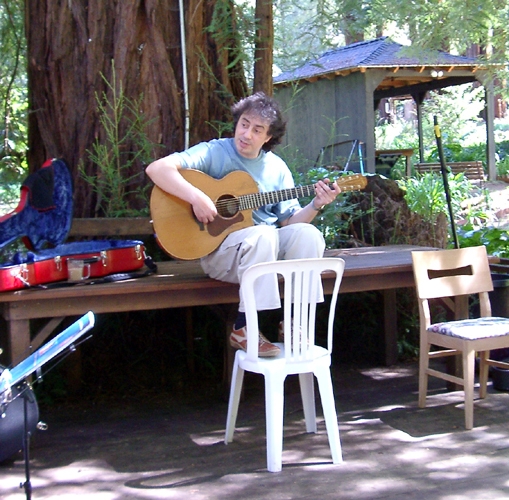
Pierre Bensusan -- March 30, 2003
© Doug Young, 2003
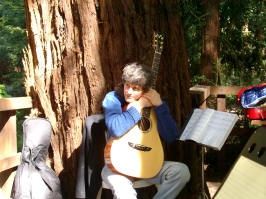
Kay Eskenazi and Pierre's Red Case
© Doug Young, 2003
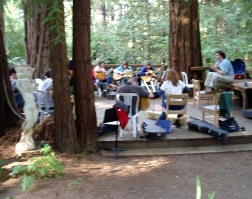
Class in the Redwoods
© Doug Young, 2003

Redwood Ceiling of Our Classroom
© Doug Young, 2003
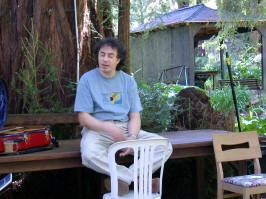
Discussing Music
© Doug Young, 2003
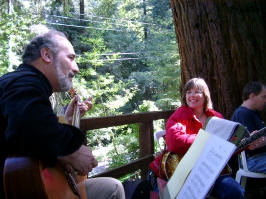
David and Lisa
© Doug Young, 2003
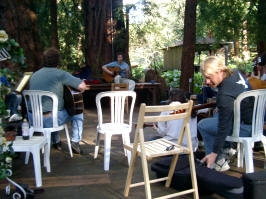
Pierre Playing Beautiful Music
© Doug Young, 2003